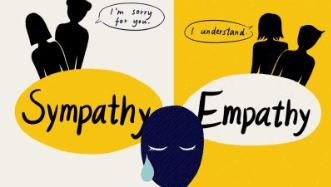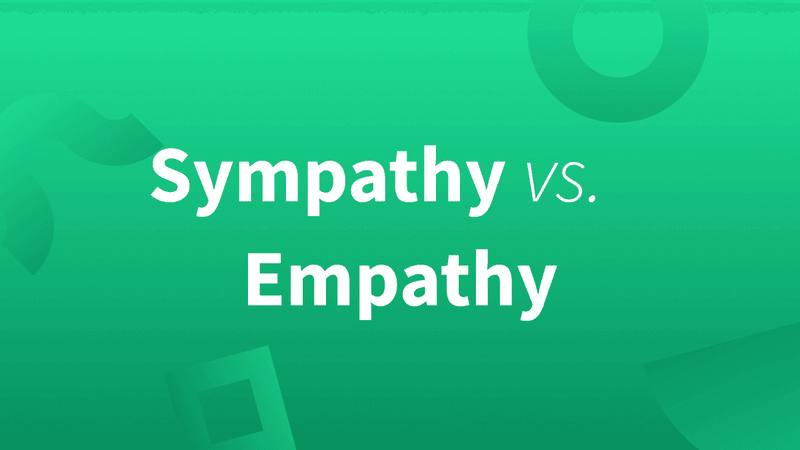Understanding Sympathy vs. Empathy: Understanding Key Concepts of Emotional Intelligence
Contents

The English language is known for its rich vocabulary. When you're learning such a language which has lots of different words and expressions, it's not always about knowing what they mean. It's also about understanding the feelings and emotions that they convey. This is especially important in the case of words like 'sympathy' and 'empathy.' Grasping the meanings and usage of these words will help you understand human relations better and communicate efficiently.
Through this blog post, you'll develop a greater understanding of these two terms. By learning their definitions and exploring real-life sympathy vs empathy examples, you'll be able to communicate more authentically in English – showing not just your language proficiency but also your emotional intelligence. Ready to dive into the fascinating world of sympathy vs empathy? Let's get started!
Sympathy vs Empathy: Meaning and Differences
Let us begin with the definition of sympathy vs empathy. Sympathy refers to the feeling of compassion or concern for someone else's grief or misfortune. It's like standing on the shore witnessing someone struggling to swim. You feel sorry for them, you wish them well, but you remain on the safe ground.
On the other hand, empathy is quite powerful. It means putting yourself in another person's shoes, and experiencing their feelings as if they were your own. It's like diving into the water to understand how it feels to struggle and then offering assistance.
Here are their distinct features:
Sympathy:
Concerned with feelings of pity
Involves feeling for someone
Can create distance as you're observing someone else's hardship
Empathy:
Involves understanding experiences and emotions
You feel with someone
Promotes connection as you step into another person’s shoes
Sympathy Vs Empathy: Examples In Everyday Conversations
In everyday conversations, "sympathy" and "empathy" often get used interchangeably. However, they indicate distinct emotional responses. When we say 'I sympathise with you', we're expressing pity or sorrow for someone's misfortune, without necessarily understanding their feelings. For example, if a friend says, "I missed my train today", a sympathetic response might be, "That's unfortunate".
On the other hand, when we 'empathise' with somebody, we are putting ourselves in their shoes and experiencing their emotions. So if your friend missed the train, an empathetic response would be: "That must have been frustrating; I understand how you feel because I've experienced that myself".
The choice between using sympathy vs empathy depends on the situation and your relationship with the person. Practice observing others' emotions and reactions to enhance your understanding of these concepts in English conversation.
Translating Sympathy And Empathy From English To Hindi
Understanding the meaning of 'sympathy' and 'empathy' in Hindi can provide clarity on the difference between sympathy vs empathy.
'Sympathy' translates to 'सहानुभूति' (Sahānubhūti) in Hindi, which means feeling sorrow for someone else's hardship. For example, consider this English sentence: "I sympathize with her for losing her job." In Hindi, it is: "मैं उसकी नौकरी खोने के लिए उसके साथ सहानुभूति प्रकट करता हूं."
On the other hand, 'empathy' translates to 'समानुभूति' (Samānubhūti), meaning experiencing others' feelings as if they were your own. Here's an example: "I empathize with his struggle to learn English." In Hindi, it's: "मैं अंग्रेजी सीखने की उसकी संघर्ष के साथ समानुभूति प्रकट करता हूं."
Remember that improving your English fluency is a journey, and every new word you learn gets you one step closer to your goal. Stay patient, keep practising, and you'll see the results!
The Importance Of Sympathy and Empathy In Professional Communication
In the professional sphere, mastering emotional intelligence which includes understanding the difference between sympathy and empathy, is essential. Misusing these terms can lead to misinterpretations and strain business relationships. Here are some practical tips for applying sympathy and empathy correctly:
Listen actively: Pay attention to words, tone and body language to understand what the other person is experiencing.
Respond thoughtfully: Use language that communicates your shared experience (empathy) or your concern for their situation (sympathy).
Validate emotions: Acknowledge the other person's feelings without judgment.
For more guidance on improving conversational skills, do explore our article Speak Softly, Speak Well: English Speaking Tips for Introverts. It provides useful insights on effective communication strategies specifically for introvert non-native English speakers in India.
Exercising Sympathy And Empathy: Real-Life Scenarios

Understanding the difference between sympathy and empathy is essential, but how do we apply it in real-life scenarios? Let's consider these examples of sympathy and empathy.
Imagine a friend didn't perform well in an interview. Expressing sympathy, you might say, "I feel bad that your interview didn't go well." Here, you're acknowledging their situation, but not necessarily connecting with their feelings. On the other hand, expressing empathy, you could say, "I can only imagine how disappointing it must be for you." Notice the difference? In the empathetic response, you're connecting with their emotions, not just recognising them.
Remember - understanding sympathy and empathy not only improves your English communication but also helps build deeper connections in personal and professional relationships.
Summing Up
So far, we have looked at the differences between the concepts 'sympathy' and 'empathy'. We've learned that while sympathy is a feeling of pity or sorrow for someone else's misfortune, empathy involves understanding and sharing another person's feelings as if stepping into their shoes. Embracing this difference can positively impact your English language skills as well as interpersonal interactions.
Remember, language isn't just about words and grammar. It’s also about expressing feelings and emotions appropriately. Knowing the difference between sympathy and empathy allows you to communicate more sensitively, and effectively. Enhancing your English speaking skills also requires practice. Clapingo offers one-on-one coaching sessions with non-judgmental native tutors to help you effectively communicate in various situations.
Keep practising with real-life situations to master these concepts. Learning is a journey, and every step counts. Clapingo is here to guide you through it one step at a time!
FAQs
1. Is "I'm sorry" sympathy or empathy?
"I'm sorry" can express both sympathy and empathy, depending on the context and your relationship with the person you are speaking to.
2. How is sympathy different from empathy?
Sympathy involves feeling for someone, whereas empathy involves feeling with someone.
3. Can you feel empathy but not sympathy?
Yes, you can feel empathy without necessarily feeling sympathy, especially if you understand someone's perspective but don't feel sorry for them.
Comments
Your comment has been submitted